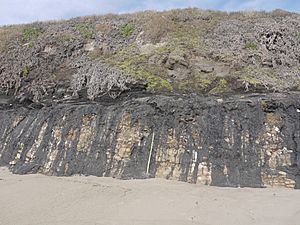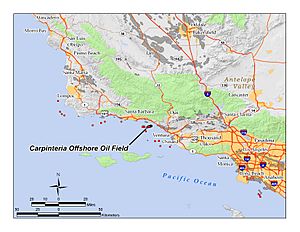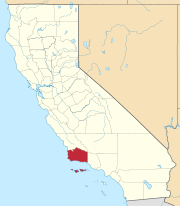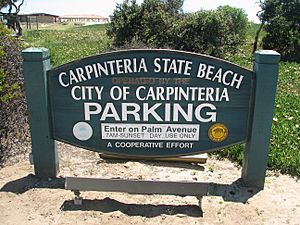Carpinteria Tar Pits facts for kids
The Carpinteria Tar Pits are natural pools of sticky, black asphalt found in southern Santa Barbara County, California. These tar pits are like natural "lakes" of asphalt.
They are similar to other famous tar pits around the world. These include Tierra de Brea in Trinidad and Tobago, Lake Guanoco in Venezuela, and the La Brea Tar Pits in Los Angeles, California. The McKittrick Tar Pits in McKittrick, California, are also a lot like them.
Where Are the Tar Pits?
The Carpinteria Tar Pits are located in the southeastern part of Santa Barbara County. They are about 20 kilometers (12 miles) southeast of the city of Santa Barbara. You can find them right in the town of Carpinteria.
This area is a special park called Tar Pits Park. It is part of the Carpinteria State Beach. The park is located between the Santa Rosa and San Miguel campsites. Most of the tar pits are right on the beach. The tar comes from oil deep underground in the Carpinteria Offshore Oil Field.
How Did the Tar Pits Form?
The Carpinteria Tar Pits likely formed during the Pleistocene epoch. This was a very long time ago, often called the Ice Age.
Natural asphalt lakes form when oil moves up from deep underground. This oil travels along cracks in the Earth's crust called faults. Sometimes, pressure from subduction (when one part of the Earth's crust slides under another) can push oil upwards.
As the oil moves towards the surface, it slowly changes into a thick, sticky substance called bitumen. On its journey through the Earth's rocky outer layer, called the lithosphere, the oil picks up clay and water. It also cools down, turning into the asphalt we see at the surface.
A Look Back in Time
The local Native American people, the Chumash people, knew about the Carpinteria Tar Pits for a very long time. They used the natural asphalt as a sealant. They would use it to waterproof their tomols, which were special boats made of planks. They also used it for many other purposes.
A Spanish group led by explorer Gaspar de Portolá arrived in the area on August 17, 1769. They named the place "La Carpinteria," which means "the carpentry." This was because they saw the Chumash people building their boats there.
Around 1915, people started mining the asphalt from the pits. They used it to help build a coastal highway. In 1933, the area was made a state beach. It officially opened to the public in 1941.
The tar pits have also trapped and preserved hundreds of ancient birds and animals from the Pleistocene Age. Some of these amazing findings are on display at the Carpinteria Valley Museum of History. However, scientists have not done many studies on these fossils. This is because the tar pits were used as a local rubbish dump for some time.
See also
 In Spanish: Pozos de brea de Carpintería para niños
In Spanish: Pozos de brea de Carpintería para niños





